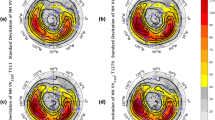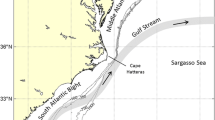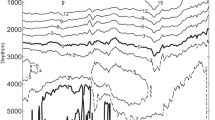Abstract
The output of several multi-century simulations with a coupled ocean–atmosphere general circulation model is examined with respect to the variability of global storm activity in winter on time scales of decades and longer. The frequency of maximum wind speed events within a grid box, using the lower limits on the Beaufort wind speed scale of 8 and 10 Bft as thresholds, is taken as the characteristic parameter. Two historical climate runs with time-dependent forcing of the last five centuries, one control simulation, and three climate change experiments are considered. The storm frequency shows no trend until recently. Global maps for the industrially influenced period hardly differ from pre-industrial maps, even though significant temperature anomalies temporarily emerge in the historical runs. Two indicators describing the frequency and the regional shift of storm activity are determined. In historical times they are decoupled from temperature. Variations in solar and volcanic forcing in the historical simulations as well as in greenhouse gas concentrations for the industrially influenced period are not related to variations in storm activity. Also, anomalous temperature regimes like the Late Maunder Minimum are not associated with systematic storm conditions. In the climate change experiments, a poleward shift of storm activity is found in all three storm track regions. Over the North Atlantic and Southern Ocean, storm activity increases, while it decreases over the Pacific Ocean. In contrast to the historical runs, and with the exception of the North Pacific storm frequency index, the storm indices parallel the development of temperature, exceeding the 2 σ-range of pre-industrial variations in the early twenty-first century.











Similar content being viewed by others
References
Alexandersson H, Schmith T, Iden K, Tuomenvirta H (2000) Trends of storms in NW Europe derived from an updated pressure data set. Clim Res 14:71–73
Andersen, UJ, Kaas E, May W (2001) Changes in the storm climate in the North Atlantic/European region as simulated by GCM timeslice experiments at high resolution. Danish Climate Centre Report, No 01-1, ISSN: 1399–1957 (Online), 15 pp
Bärring L, von Storch H (2004) Northern European Storminess since about 1800. Geophys Res Lett 31:L20202. doi:10.1029/2004GL020441:1–4
Beersma JJ, Rider KM, Komen GJ, Kaas E, Kharin VV (1997) An analysis of extratropical storms in the North Atlantic region as simulated in a control and 2’CO2 time-slice experiment with a high-resolution atmospheric model. Tellus 49A:347–361
Carnell RE, Senior CA, Mitchell JFB (1996) An assessment of measures of storminess: Simulated changes in Northern Hemisphere winter due to increasing CO2. Clim Dynam 12:467–476
Carnell RE, Senior CA (1998) Changes in mid-latitude variability due to increasing greenhouse gases and sulfate aerosols. Clim Dynam 14:369–383
Crowley T (2000) Causes of climate change over the past 1000 years. Science 289:270–277
de Kraker AMJ (1999) A method to assess the impact of high tides, storms and storm surges as vital elements in climate history. The case of stormy weather and dikes in the Northern part of Flanders, 1488–1609. Clim Change 43:287–302
Fischer-Bruns I, Cubasch U, von Storch H, Zorita E, Gonzáles-Rouco JF, Luterbacher J (2002) Modelling the Late Maunder Minimum with a 3-dimensional Ocean-Atmosphere GCM. CLIVAR Exchanges, No. 25 (vol 7, no 3/4), pp. 59–61. International CLIVAR Project Office, Southampton, UK, ISSN No. 1026–0471
Friedman RM (1989) Appropriating the weather. Vilhelm Bjerknes and the construction of a modern meteorology. Cornell University Press, 251 p. ISBN 0 8014-2062-8
González-Rouco JF, Zorita E, Cubasch U, von Storch H, Fischer-Bruns I, Valero F, Montavez JP, Schlese U, Legutke S (2003) Simulating the climate since 1000 A.D. with the AOGCM ECHO-G. In: Proceedings of the ISCS 2003 symposium, ’Solar Variability as an Input to the Earth’s Environment’, Tatranská Lomnica, Slovakia, 23–28 June 2003. ESA SP-535, 329–338
IPCC (2001) Climate change 2001, the scientific basis. In: Houghton JT, Ding Y, Griggs DJ, Noguer M, van der Linden PJ, Xiaosu D (eds) Contribution of working group I to the third assessment report of the intergovernmental panel on climate change (IPCC). Cambridge University Press, UK, p 944
Kaas E, Li T-S, Schmith T (1998) Northeast Atlantic winter storminess 1875–1995 re-analysed. Clim Dynam 14:529–536
Kharin VV, Zwiers FW (2000) Changes in the extremes in an ensemble of transient climate simulations with a coupled atmosphere-ocean GCM. J Climate 13: 3670–3688
Knippertz P, Ulbrich U, Speth P (2000) Changing cyclones and surface wind speeds over the North Atlantic and Europe in a transient GHG experiment. Clim Res 15:109–122
Knippertz P, Christoph M, Speth P (2003) Long-term precipitation variability in Morocco and the link to the large-scale circulation in recent and future climate. Meteorol Atmos Phys 83:67–88
Lamb HH (1977) Climate: present, past and future, vol 2. Climatic history and the future. Methuen, London, 835 p
Legutke S, Voss R (1999) The Hamburg atmosphere–ocean coupled circulation model ECHO-G. Technical report no. 18, German Climate Computer Center (DKRZ), Hamburg
Legutke S, Maier-Raimer E (1999) Climatology of the HOPE-G global ocean—sea ice general circulation model. Technical report no. 21, German Climate Computer Center (DKRZ), Hamburg
Mann M, Bradley RS, Hughes MK (1998) Global-scale temperature patters and climate forcing over the past centuries. Nature 392:779–789
Meehl GA, Boer GJ, Covey C, Latif M, Stouffer RJ (2000) The Coupled Model Intercomparison Project (CMIP). Bull Am Meteorol Soc 81:313–318
Min SK, Legutke, Hense A, Kwon W-T (2004) Climatology and internal variability in a 1000-year control simulation with the coupled climate model ECHO-G. M&D Technical Report, No. 2, Max Planck Institute for Meteorology, Hamburg, Germany, 67pp (http://mad.zmaw.de/Pingo/reports/TeReport_Web02.pdf)
Müller P, von Storch H (2004) Computer modelling in atmospheric and oceanic sciences—on building knowledge. Springer, Berlin Heidelberg New York, 304 p. ISN 1437-028X
Nakicenovic N, Swart R (eds) (2000) Emission scenarios. Special report of the intergovernmental panel on climate change (IPCC) on Emission Scenarios. Cambridge University Press, UK. (http://www.grida.no/climate/ipcc/emission/index.htm)
Raible CC, Blender R (2004) Northern hemisphere mid-latitude cyclone variability in different ocean representations. Clim Dynam 22: 239–248
Roeckner E, Arpe K, Bengtsson L, Brinkop S, Dümenil L, Esch M, Kirk E, Lunkeit F, Ponater M, Rockel B, Sausen R, Schlese U, Schubert S, Windelband M (1992) Simulation of the present-day climate with the ECHAM model: Impact of model physics and resolution. Report no. 93, Max-Planck-Institut für Meteorologie, Bundesstr 55, Hamburg
Roeckner E, Arpe K, Bengtsson L, Christoph M, Claussen M, Dümenil L, Esch M, Giorgetta M, Schlese U, Schulzweida U (1996) The atmospheric general circulation model ECHAM4: model description and simulation of present-day climate. Report no. 218, Max-Planck-Institut für Meteorologie, Bundesstr 55, Hamburg
Schmidt H, von Storch H (1993) German Bight storms analyzed. Nature 365:791
Sinclair MR, Watterson IG (1999) Objective assessment of extratropical weather systems in simulated climates. J Climate 12:3467–3485
Stendel M, Roeckner E (1998) Impacts of horizontal resolution on simulated climate statistics in ECHAM4. Report no. 253, Max-Planck-Institut für Meteorologie, Bundesstr 55, Hamburg
Stone DA, Weaver AJ, Stouffer RJ (2001) Projections of climate change onto modes of atmospheric variability. J Climate 14: 3551–3565
Stone DA, Fyfe JC (2005) The effect of ocean mixing parametrisation on the enhanced CO2 response of the Southern Hemisphere midlatitude jet. Geophys Res Lett (in press)
Ulbrich U, Christoph M (1999) A shift of the NAO and increasing storm track activity over Europe due to anthropogenic greenhouse gas forcing. Clim Dynam 15:551–559
von Storch H, Stehr N (2000) Climate change in perspective. Our concerns about global warming have an age-old resonance. Nature 405:615
von Storch H, Zorita E, Jones J, Dimitriev Y, González-Rouco JF, Tett S (2004) Reconstructing past climate from noisy data. Science 306:679–682
WASA (1998) Changing waves and storms in the Northeast Atlantic. Bull Am Met Soc 79:741–760
Weisse R, von Storch H, Feser F (2005) Northeast Atlantic and North Sea storminess as simulated by a regional climate model 1958–2001 and comparison with observations. J Climate 18:465–479
Wolff J-O, Maier-Reimer E, Legutke S (1997) The Hamburg Ocean primitive equation model. Technical report, no. 13, German Climate Computer Center (DKRZ), Hamburg
Zinke J, von Storch H, Müller B, Zorita E, Rein B, Mieding HB, Miller H, Lücke A, Schleser GH, Schwab MJ, Negendank JFW, Kienel U, González-Ruoco JF, Dullo C, Eisenhauer A (2004) Evidence for the climate during the Late Maunder Minimum from proxy data available within KIHZ. In: Fischer H, Kumke T, Lohmann G, Flöser G, Miller H, von Storch H, Negendank JFW (eds) The KIHZ project: towards a synthesis of Holocene proxy data and climate models. Springer Berlin Heidelberg, New York, pp 397–414
Zorita E, Storch H, Gonzales-Rouco JF, Cubasch U, Luterbacher J, Legutke S, Fischer-Bruns I, Schlese U (2004) Transient simulation of the climate of the last five centuries with an atmosphere-ocean coupled model: the Late Maunder Minimum and the Little Ice Age. Meteorol Z 13:271–289
Zwiers FW, Kharin VV (1998) Changes in the extremes of climate simulated by CCC GCM2 under CO2-doubling. J Climate 11:2200–2222
Acknowledgements
This work was partially funded by the ‘Sonderforschungsbereich’ (SFB) 512 sponsored by the ‘Deutsche Forschungsgemeinschaft’ (DFG) and by the KIHZ project of ‘Helmholtz-Gemeinschaft Deutscher Forschungszentren e.V.’ (HGF). The ECHAM4/HOPE-G was provided as community model by the Model & Data Group at the Max-Planck Institute for Meteorology. The model simulations have been integrated at the DKRZ climate computing center. We thank Reiner Schnur for helpful suggestions. Discussions with John Fyfe and George Boer were constructive and helpful as well. We gratefully acknowledge the help of Norbert Noreiks in adapting some of the figures.
Author information
Authors and Affiliations
Corresponding author
Rights and permissions
About this article
Cite this article
Fischer-Bruns, I., Storch, H.v., González-Rouco, J.F. et al. Modelling the variability of midlatitude storm activity on decadal to century time scales. Climate Dynamics 25, 461–476 (2005). https://doi.org/10.1007/s00382-005-0036-1
Received:
Accepted:
Published:
Issue Date:
DOI: https://doi.org/10.1007/s00382-005-0036-1




